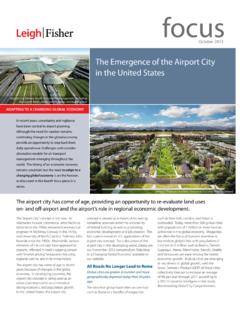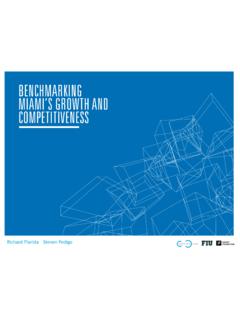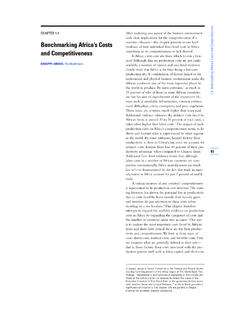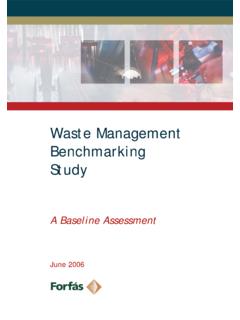Transcription of The Emergence of the Airport City in the United States
1 The Airport city has come of age, providing an opportunity to re-evaluate land uses on- and off - Airport and the Airport s role in regional economic development. The Emergence of the Airport Cityin the United StatesOctober 2013focusThe Airport city concept is not new. Its visionaries include commercial artist Nicholas DeSantis in the 1930s; renowned aeronautical engineer H. McKinley Conway in the 1970s; and University of North Carolina Professor John Kasarda since the 1990s. Meanwhile, various elements of the concept have appeared at airports, refl ected in retail shopping venues with market pricing, restaurants featuring regional cuisine, and in-terminal hotels. The Airport city has come of age in recent years because of changes in the global economy.
2 In developing countries, the Airport city concept is being used as an urban planning tool to accommodate strong economic and population growth. In the United States , the Airport city concept is viewed as a means of increasing nonairline revenues amid the uncertainty of federal funding, as well as promoting economic development and job creation. This focus piece examines applications of the Airport city concept. For a discussion of the Airport city in the developing world, please see our November 2012 compendium Adapting to a Changing global Economy available on our website. All Roads No Longer Lead to RomeGlobal cities are greater in number and more geographically dispersed today than 20 years ago.
3 The idea that global trade relies on one hub such as Rome or a handful of megacities In recent years, uncertainty and vigilance have been central to Airport planning. Although the need for caution remains, continuing changes in the global economy provide an opportunity to step back from daily operational challenges and consider alternative models for air transport management emerging throughout the world. The timing of an economic recovery remains uncertain but the need to adapt to a changing global economy is on the horizon, as discussed in this fourth focus piece in a TO A CHANGING global ECONOMY such as New York, London, and Tokyo is outmoded. Today, more than 500 global cities with populations of 1 million or more have an active role in the global economy.
4 Megacities are often the focus of business investment, but midsize global cities with populations of 2 million to 5 million, such as Brasilia, Denver, Guayaquil, Hanoi, Manchester, Nairobi, Seattle, and Vancouver, are experiencing the fastest economic growth. Midsize cities are emerging as key drivers of global growth, with the Gross Domestic Product (GDP) of these cities collectively forecast to increase an average of 9% per year through 2017, according to a 2012 Economist Intelligence Unit study, benchmarking global city competitiveness . Denver s Proposed Aviation Station at 61st and Pena BoulevardAirport city Denver, South Terminal Redevelopment including the Airport hotel, public transit center, and public plazafocus The Emergence of the Airport city in the United is for ConnectivityConnectivity is key to the continued growth of global cities and Emergence of Airport cities.
5 Although there is no industry-standard metric of connectivity, recent research by the MIT International Center for Air Transportation defi nes Airport connectivity as a function of the frequency of scheduled fl ights and the quantity and quality of destinations served nonstop and with connecting service. In the MIT study, the overall connectivity of an Airport is higher if there is airline service to large hubs and international gateways where there are more opportunities for connecting service to a large number of destinations. For example, a small-hub Airport s overall connectivity rating would increase more with airline service to a large hub than it would with service to another small the Airport CityElements of an Airport city are present at many the United States , elements of an Airport city have been developed incrementally with the addition of restaurants and specialty retail, hotels, business offi ce complexes, free trade zones, leisure and fi tness facilities, and cultural attractions such as museums and art displays.
6 In-terminal hotels with conference centers and meetings rooms are located at 11 airports; a 12th is under construction An illustration of a London aerodrome consisting of four runways in the form of a giant wheel supported by the city s buildings, proposed by London architect Charles Clever, and published in Modern Mechanics and Inventions in illustration of the Airport -Docks for New York proposed by New York architect Harry B. Brainerd, and published in Everyday Science and Mechanics in 1,000 1,500 Large-hubMedium-hubSmall-hubNon-hubSourc es: Ranking of most connected airports MIT International Center for Air Transportation, Modeling Changes in Connectivity at Airports: A Small Community Perspective, June 2013.
7 Scheduled departures OAG Aviation Worldwide Ltd., online database, accessed June daily scheduled departures in August 2013 InternationalRANKING OF THE TOP 15 MOST CONNECTED AIRPORTS IN THE United STATES1. Chicago O'Hare2. Atlanta3. Dallas/Fort Worth4. Los Angeles5. Denver6. Charlotte7. Houston Intercontinental8. Newark9. New York LaGuardia10 New York Kennedy11 Phoenix12 Philadelphia13 San Francisco14 Boston15 MiamiThe Skyscraper Airport for city of Tomorrow proposed by Nicholas DeSantis, published in Popular Science in 1939. Already global business is beginning to plan strategy from a city , rather than a country, perspective. The Economist Intelligence Unit benchmarking global city competitiveness , 2012 Airport city Concepts From The Past !
8 " # $ % &# $ % #' ! & # $ % & % (focus The Emergence of the Airport city in the United Denver International Airport . airports feature displays of aviation memorabilia and regional art such as the Aviation Museum and terminal exhibits at Las Vegas McCarran International Airport . In 2012, San Francisco International Airport opened a post-security yoga room that is available to all ticketed passengers. One Size Does Not Fit AllApplications of the Airport city concept will be aff ected by physical, competitive, political, and fi nancial recent years, Airport city projects have been launched at a number of airports, including the airports located in Atlanta, Dallas/Fort Worth, Dayton, Denver, Detroit, Greensboro, Indianapolis, Memphis, and Pittsburgh.)
9 The scale varies, depending on the amounts of available land, private capital, existing infrastructure, and regional Airport competition. Applications of the Airport city concept range from large-scale development of a greenfi eld site (primarily outside the United States ), to development of large tracts of available land at an existing Airport , to incremental development of business parks on Airport city Denver In 2012, Denver International Airport (DIA) and the city and County of Denver announced their vision for Airport city Denver at the global Airport Cities Conference and Exhibition hosted in Denver by DIA. A key feature of the Airport city Denver vision is to target specifi c economic clusters of complementary businesses including aviation, aerospace, logistics, renewable energy, bioscience and agrotech, and their supporting technologies and industries.
10 The fi rst phase of Airport city Denver is under way. A 519-room Airport hotel is scheduled for completion in 2015, to be followed by the 2016 completion of a commuter rail line connecting DIA to Denver s Union Station. Future phases are focused on an economic development strategy that would leverage DIA s property assets to increase global connectivity and competitiveness while generating, nonairline revenues and further stimulating the regional economy. VantagePort In July 2013, the Detroit Region Aerotropolis was rebranded as VantagePort as part of a 25-year strategy to market, plan, and support development within a 60,000-acre region in and around Wayne County s Detroit Metropolitan and Willow Run airports.









